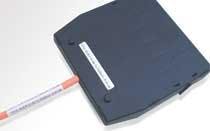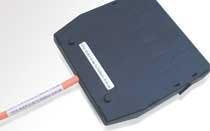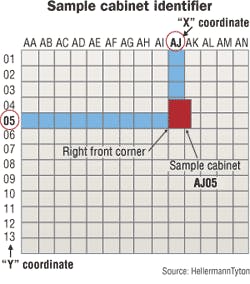Some may think it more tedious at first, but in the long run, revised labeling for data centers could prove to be a huge troubleshooting time-saver.
by Betsy Ziobron
A properly labeled and documented network is a task that most installers loathe and many still avoid when possible. But changes are on the way that, while at first may appear to make labeling more tedious, in the end will save data center managers huge amounts of time during reconfigurations and troubleshooting.
ANSI/TIA/EIA-606-A Administration Standard for Commercial Telecommunications Infrastructure was last updated in early 2002 andreaffirmed in June 2007. Currently, a TR-42.6 Subcommittee on Telecommunications Infrastructure and Equipment Administration is finalizing Addendum 1 (TIA-606-A-1) to the current standard.
“We were completely satisfied with 606-A, but after it was reaffirmed, we realized that we needed to better identify racks, cabinets, patch panels, and cabling within data centers,” says Jonathan Jew, vice chair of the subcommittee and president of J&M Consultants, Inc. (www.j-and-m.com).
Identifying racks and cabinets
Adding identifiers for cabinets and racks in a datacenter has become a necessity for all but the smallestof networks.
“The 606-A standard didn’t take racks and cabinetsinto account, which was really not an issue for small spaces with just a few racks,” says Todd Fries, marketing manager of identification systems for Hellermann-Tyton (www.hellermann.tyton.com) and member of the subcommittee. “With today’s larger data centers, quickly finding the right patch panel and port starts with quickly finding the rack or cabinet that houses the patch panel. In the past, some have created their own system for identifying cabinets in a data center, but Addendum 1 is meant to simplify and bring consistency to the process.”
According to Fries, creating rack/cabinet identifiers in the data center will be accomplished by using X and Y coordinates that relate to floor tiles in a raised-floor system or to the number or rows and cabinets in a simple data center floor plan. The “X” coordinate is analpha character and the “Y” numeric, resulting in aunique alphanumeric identifier for each rack andcabinet. The current draft of Addendum 1 specifies that the rack/cabinet identifier label shall be placed at the top and bottom on both the front and rear of each rack or cabinet.
Just as in 606-A, each telecommunications space also has a unique identifier where “F” is a numeric character that identifies the floor of the building, and “S” is an alpha character thatdefines the space. In Addendum 1, The XY cabinet identifier follows the FS identifier (FS.XY), creating an identifier for racks and cabinets that can be applied to any space.
“The X and Y coordinates for a rack or cabinet do not have to be based on grid coordinates,” explains Fries. “For smaller data centers, it may make more sense to use rows and racks, or just racks. For example, R2R05 would denote Rack 5 located in Row 2, and R4 would simply denote Rack 4 in a small space that contains just a few racks.”
With FS.XY part of the identifier for all ports and links,data center managers can quickly locate exactly which floor, space, and cabinet to go to for reconfigurations or troubleshooting. With downtime as the number one concern, the time saving could be significant.
Improved ports and panels
The current draft of Addendum 1 to 606-A also contains improved identifiers for patch panels and ports. Patch panel identifiers will now use one or two characters to designate the patch panel location starting at the top of the cabinet.
“We used to identify patch panels as simply A, B, C, D, etc., but Addendum 1 enables patch panels to be identified based on rack units, which makes much more sense,” says Jay Whitaker, business development manager for Panduit (www.panduit.com) and member of the TR-42.6 Subcommittee.“Using rack spaces as part of the identifier allows data center managers to add a patch panel to an unused rack unit space without throwing off the sequence.”
Because a numeric character can now be used to identify a patch panel based on rack units, Addendum 1 also calls for the use of a colon between the panel and port identifiers. “When using rack units to identify patch panels, it would be confusing to use 0202 to denote Port 2 in the patch panel located at Rack Unit 2,” explains Whitaker. “By adding a colon [02:02], it becomes clear that it’s Patch Panel 2 and Port 2.”
According to Whitaker, Addendum 1 also addresses the labeling of sub panels. “Fiber enclosures may have six sub panels, and by labeling each sub panel, it becomes clear from the remote end exactly which sub panel a port is terminated to,” he explains. “This prevents having to check each sub panel to find the right connection, which is espe-cially important when dealing with sensitive fiber connections that you don’t want to touch if you don’t have to.”
Addendum 1 also includes labels that identify where a group of ports on a patch panel connect to within the same space. The current 606-A standard simply identified the port, which can beineffective for maintenance.
“What managers really need to know is where ports actually connect to on the other end,” says Whitaker. “Systems today are often mission critical, and with equipment being constantly upgraded and replaced, data center managers are starting to see the importance of being able to quickly locate where a specific connection is coming from or going to.”
On to 606-B
Addendum 1 to 606-A will likely be approved and published by mid-year following resolution of a few minor issues. “One minor issue facing Addendum 1 is the administration of backbone fibers and whether to identify by individualfiber strand, by port, or allow the option of both,” says Jew. “My hope is that the committee will agree to permit both.”
According to Jew, the TR-42.6 Working Group has granted approval to proceed with TIA-606-B, which will include Addendum 1, as well as expanded and new identification formats for other elements, such as horizontal links, backbone cables, outlets, consolidation points, fiber splices, outsidespaces, and grounding and bonding systems. For example,GPS coordinates may be added to identifiers for outside maintenance holes, “SPz” may be used to identify splices where “z” is the approximate distance to the splice from the patch panel, and specific objects being bonded to a ground bar or bonding network will be identified in grounding and bonding systems.
“It is likely that we will also address automated management systems and possibly address non-telecom cabling, but so far, no specific content has been proposed,” says Jew. “My guess is that 606-B will take about two years to finalize.” He notes that under 606-B, 606-A formats will be permitted forexisting administration systems where they are already in use, avoiding the need to create new identifiers and labels forexisting elements.
There is also concern about the future 606-B standard meshing with international standards, and the subcommittee has submitted the current proposed changes in 606-B to ISO/IEC for incorporation in the revision of ICO/IEC 14763-2 Information Technology – Implementation and Operation of Customer Premises Cabling Part 2, which will replace a number of current ISO/IEC standards.
“There are two philosophies, one that resembles 606-B and another out of Sweden [SEK] that is somewhat different,”explains Jew. “Depending on workload, the ISO/IEC Task Group may decide on one of the proposals at the February 2008 Barcelona meeting, May 2008 Philadelphia meeting, or October 2008 meeting in France. We’ll have to wait to see which philosophy wins.”
Fighting resistance
But even as the TR-42.6 Subcommittee continues to improve the labeling standard and work on 606-B, the industry is still faced with the fact that not all installers follow the standard. There are concerns that the longer identifiers included inAddendum 1 will make labeling seem even more tedious. But Jew says, “If labeling is automated, the slightly longer labels shouldn’t take all that much more time.”
Estimates show that only about 50% of installers are following the current 606-A standard, and specifications fromdesigners and end users play a role.
“Typically, if the specification dictates that the installer follow the standard, they will,” concludes Panduit’s Whitaker. “However, contractors should always remind end users of the long-term benefits of following the standard, which include improvedcabling infrastructure management over the life of the data center.”
BETSY ZIOBRON is a freelance writer and regular contributor to Cabling Installation & Maintenance. She can be reached at: [email protected]


